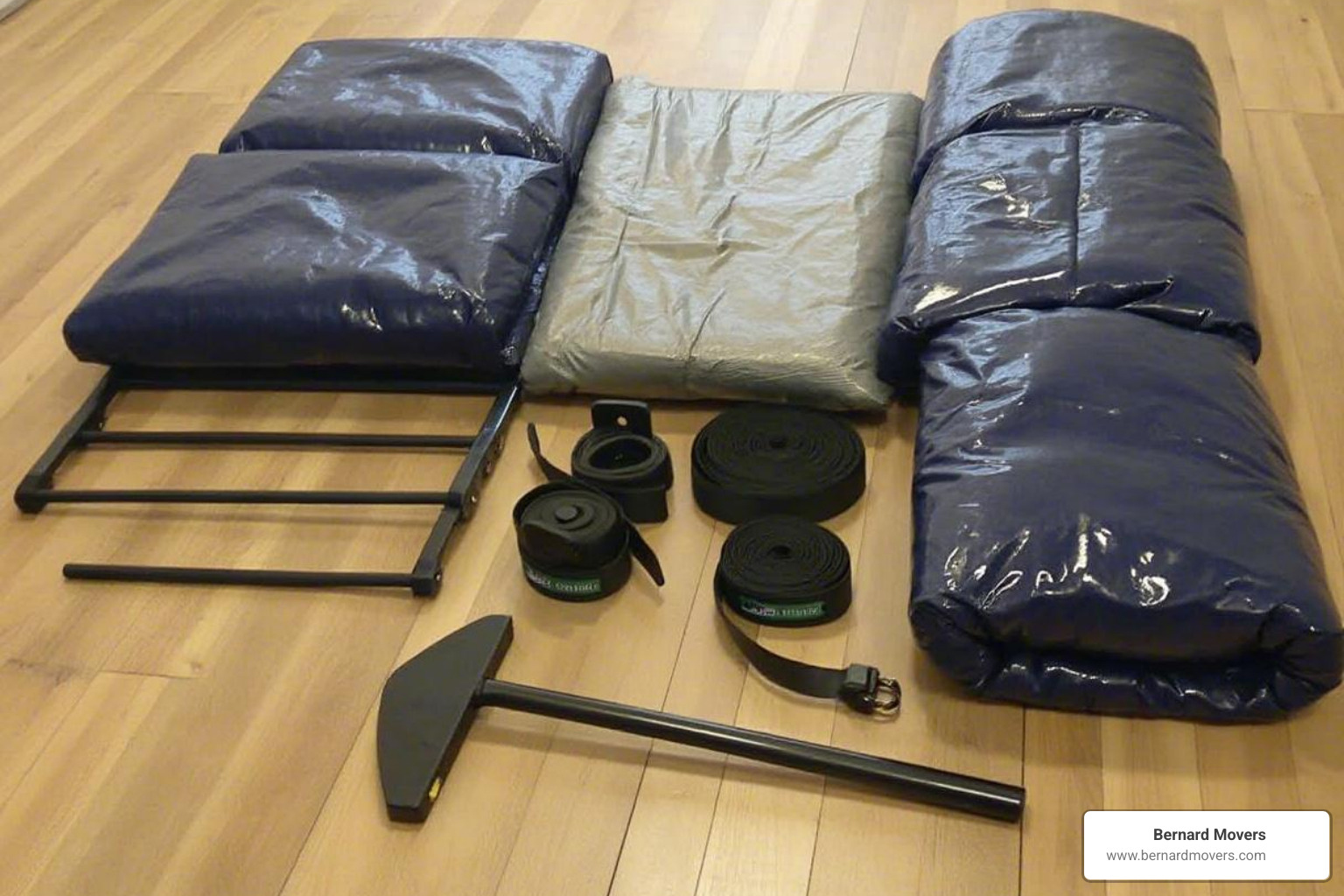Why Proper Piano Packing Makes All the Difference
Learning how to pack a piano for moving isn’t hard, but it is exact. A piano can weigh 300–1,200 lb and has more than 10,000 parts that hate bumps, moisture, and sudden drops. A slip can turn a family heirloom into an expensive repair.
Quick reminder of the core steps:
- Gather supplies – pro-grade blankets, shrink wrap, straps, dolly or skid board
- Prepare the piano – lock the keyboard lid, photo any pre-existing scratches, pad pedals
- Wrap – thick blankets first, then shrink-wrap “cocoon,” finish with ratchet straps
- Load – 3–5 helpers, correct lifting form, center on the dolly or skid board
- Secure in truck – flat against a wall, strap tight, never stack boxes on top
I’m Mina Georgalas, president of Bernard Movers. After nearly 30 years moving pianos in 45 states, I’ve learned that careful prep is cheaper than any repair bill.
Important terms you may need next:
- how to disassemble an upright piano for moving
- how to make a piano moving dolly
- upright piano moving cost
Understanding Piano Types & Weight Challenges
Packing starts with knowing what you own. Upright, grand, and digital pianos each demand different gear and crew sizes.
| Piano Type | Weight | Crew | Key Gear |
|---|---|---|---|
| Upright | 300–800 lb | 3–4 | Piano dolly, blankets |
| Baby Grand | 500–700 lb | 4–5 | Skid board, leg tools |
| Full Grand | 700–1,500 lb | 5–6 | Pro skid board, lift straps |
| Digital | 50–200 lb | 2–3 | Original box, anti-static wrap |
Why it matters:
- Soundboard fragility – even a hairline crack kills tone.
- Casters are decorative – never roll a piano on its tiny wheels.
- Leg removal on grands – legs aren’t built for truck vibration; always detach.
Common rookie mistakes:
- Rolling on casters and snapping a leg.
- Thinking two quilts count as padding—use thick moving blankets.
- Ignoring humidity swings that warp wood and detune strings.
Sort these basics now, and the rest of how to pack a piano for moving will be far easier.
Essential Supplies & Pre-Packing Preparation

Must-have kit (upright = 4 blankets, grand = 6 +):
- Heavy moving blankets
- Industrial stretch wrap
- Large-bubble wrap (pedals, legs)
- 2–4 ratchet straps rated >150% of piano weight
- Piano dolly (upright) or skid board (grand)
- Tool kit, grip gloves, floor runners
Prep checklist:
- Measure piano AND every doorway—add 1 in. for padding.
- Clear a straight path; remove rugs, décor, low-hanging lights.
- Lay cardboard or plastic to guard floors.
- Photograph the piano on all sides for insurance.
- Check the weather; avoid extreme humidity or sub-freezing temps.
DIY vs rental gear: homemade dollies rarely hit proper weight specs. Renting pro gear ($20–$100/day) is safer and cheaper than a cracked soundboard.
Finally, brief your crew. Assign lifting roles and do two minutes of stretches—backs will thank you later.
Step-by-Step Guide: How to Pack a Piano for Moving

Universal “Cocoon” Method
- Secure the keyboard lid – lock or tape shut.
- Pad pedals & corners – bubble wrap + cardboard guards.
- Blanket wrap – overlap by 6 in., tape lightly.
- Strap – ratchet straps compress blankets tight.
- Stretch wrap – full body seal against dirt and moisture.
- Slide lifting straps under before the first lift.
Assign one person as captain who calls every move.
Upright Shortcut
- Lock fallboard.
- Wrap pedals.
- Tip 10–15° and slide dolly underneath.
- Use a short ramp for stairs; one spotter low, one high.
- Strap upright flat to truck wall—no boxes on top.
More detail: packing an upright piano for moving.
Grand / Baby Grand Basics
- Remove and blanket-wrap lid.
- Detach lyre and pedals; bag hardware.
- Unbolt legs, wrap and label each.
- Lay piano on its side onto skid board, keys up.
- Strap to board using built-in anchors.
- Load at an angle—grands are longer than you think.
Step-by-step disassembly: how to disassemble an upright piano for moving.
Digital Keyboards
Original box + foam > anything else. Tape keys, add silica gel, then box-in-box for road trips.
Transport & Environmental Protection

Load the piano flat against a truck wall, resting on plywood to spread weight. Use two ratchet straps at keyboard height and bass end—tight, but not crushing.
If possible, rent a truck with air-ride suspension; every mile of smoother travel saves internal parts.
Climate tips:
- Avoid big humidity swings; a sealed, climate-controlled trailer is best for long hauls.
- Never leave a wrapped piano overnight in an unheated truck.
Going interstate? Photograph condition, verify insurance, and know local weight rules. After delivery, let the piano acclimate 2–4 weeks before tuning.
Need full white-glove service? See our pro options: piano moving.
Post-Move Setup, Tuning & Safety

Welcome home! Even though the hardest part of how to pack a piano for moving is behind you, your piano still needs some care before you can play it in your new space.
First, let your piano get used to its new surroundings. This acclimation period is essential. Set the wrapped piano in its final spot and wait at least 24 hours before unwrapping anything. Sudden temperature and humidity changes can create condensation—something pianos really don’t like! A little patience here helps prevent sticky keys and warped wood.
When you’re ready, unwrap the piano with care. Take off straps and stretch wrap first, then gently remove each blanket, checking for dents or scratches as you go. If you spot anything unusual, snap a photo right away. Documenting condition now is important for insurance and peace of mind.
Choosing the perfect place for your piano isn’t just about looks. Avoid putting it next to heating vents, air conditioning, or direct sunlight. Heat and cold can cause the wood to swell or shrink, making your piano go out of tune.
If you’re moving a grand or baby grand piano, now’s the time to reattach the legs and lyre—but don’t rush! Make sure all hardware is tight and that the piano sits level. For uprights, check that everything feels steady and that the pedals are working as they should.
After all that moving, your piano might look a little dusty. Use a soft, dry cloth to gently wipe it down. Skip harsh cleaners—piano finishes are delicate.
It’s normal for an acoustic piano to need tuning after a move. The trip and environmental changes almost always knock it out of tune. Wait 2-4 weeks before calling in your piano tuner—this gives your instrument time to settle into its new home. Leave tuning to the pros.
Before anyone gets too excited, do a quick family safety walkthrough. Show everyone the piano’s new home, remind little ones (and curious adults) not to climb on it or hide underneath, and check that the bench is safely in place.
When to Call Professionals After the Move
Sometimes, even with the best planning, things don’t go perfectly. If you notice sticking keys, non-working pedals, or odd noises, don’t try to fix them yourself. Pianos are complicated—so it’s best to call a qualified technician.
Visible cracks in the wood (especially the soundboard), or any serious changes in how the piano sounds or feels, should also be checked right away. Some cracks are only cosmetic, but others can be a big deal for your instrument’s life and value.
And if you spot real damage that happened during the move, file an insurance claim as soon as possible. Your photos and notes from before and after the move will make the process much smoother.
Moving your piano is a big job, but with careful setup and patience, your family’s music will fill your new home in no time. If you have any worries along the way, remember—Bernard Movers is here to help, every step of the way.

Frequently Asked Questions about Packing & Moving Pianos
How many people do I really need to move my piano?
The number of helpers you need depends on the type of piano and the layout of your home.
For upright pianos, you’ll want at least three to four people. You’ll need someone at each end, one person to help guide the dolly, and a spotter to keep an eye out for tricky corners or bumps. For a baby grand, plan for four to five people. Full grand pianos are the real heavyweights—five to six people is safest for those.
When it comes to moving a piano, having more people is always better than relying on just a few strong arms. It’s about balance, communication, and keeping everyone (and your piano) safe. It’s much easier to keep control and avoid accidents when the weight is distributed among a good-sized crew.
If you’re ever unsure, it’s wise to err on the side of caution and recruit an extra set of hands. No piano is worth a strained back or a scratched floor!
Will my piano go out of tune immediately after the move?
Every acoustic piano will need tuning after a move. The jostling of the move, changes in humidity, and temperature swings all play a part.
Your piano probably won’t sound wildly out of tune the minute it’s unwrapped. Usually, it’s the days and weeks after the move—while your piano gets used to its new surroundings—that the tuning may drift.
We suggest giving your instrument two to four weeks to acclimate to its new home before scheduling a tuning. This gives the wood, strings, and inner workings time to settle, so your post-move tuning will last much longer.
What insurance should I arrange before transport?
Insurance for your piano is important—don’t assume your standard policy covers everything.
Most basic moving insurance only pays by the pound, and since pianos are heavy but also high-value, that might not come close to covering repairs or replacement. For example, if your upright weighs 500 pounds, basic coverage might only pay $300—nowhere near the value of most pianos.
That’s why we recommend considering full-value protection. This lets you declare your piano’s value and ensures you’re properly covered should anything happen. If you have homeowner’s or renter’s insurance, check the fine print—many plans exclude damage during a move, or require a special rider, especially for expensive instruments.
If you’re hiring professional movers, ask about their piano-specific insurance. At Bernard Movers, we offer specialized policies designed to protect high-value instruments.
Before you start packing, take lots of photos of your piano from every angle, including any existing dents or scratches. This documentation is crucial if you ever need to file a claim.
Taking these steps means you can focus on the excitement of your move, knowing your cherished piano is protected every step of the way. If you have any doubts or need guidance about insurance, don’t hesitate to contact Bernard Movers—we’re always happy to walk you through your options.
Have more questions about how to pack a piano for moving? The Bernard Movers team is just a call or click away. We’re here to help you (and your piano) move with confidence.
Conclusion
Learning how to pack a piano for moving is more than just following a checklist—it’s about treating your instrument with the care and respect it deserves. Whether you’re moving an upright down the street or a grand piano across state lines, the key steps are always the same: take your time, use the right supplies, and never underestimate the complexity of the job.
Pianos aren’t just pieces of furniture. They’re often a part of the family, holding memories and stories in every note. With the right preparation, you can keep both the instrument and its sentimental value safe—no matter where life takes you next.
At Bernard Movers, we’ve helped thousands of families protect their beloved pianos, and we know just how much these instruments mean. If you’re feeling confident and ready to tackle your move, we hope these how to pack a piano for moving tips help you every step of the way. But if you ever feel uncertain or just want a little extra peace of mind, our experienced team is here to lend a hand.
Here’s a little something to make things easier: we’re offering a special 20% additional discount on moves to Georgia and Florida, as long as you book your delivery by March 15, 2025. It’s our way of making professional piano moving a bit more affordable—because everyone deserves expert care for their family heirlooms.
If you’d like to learn more about our piano moving services (or just want to chat about your unique situation), visit our Moving Pianos page or reach out to us directly. Some moves really are worth calling in the pros—especially when it comes to something as treasured as your piano.
No matter which path you choose, remember: with careful planning and a little know-how, your piano can arrive safe, sound, and ready to fill your new home with music for years to come. Happy moving—and don’t forget to schedule that post-move tuning!

